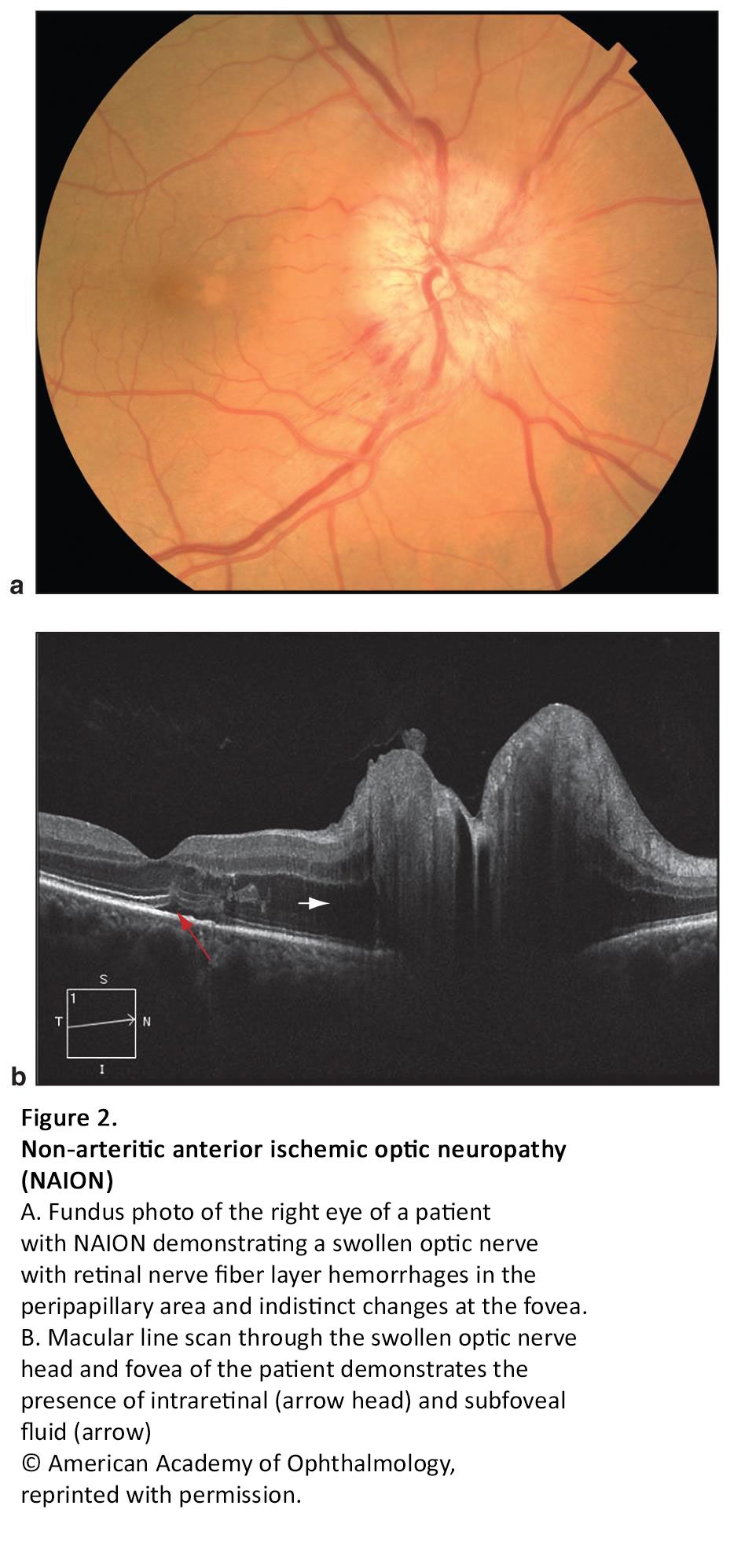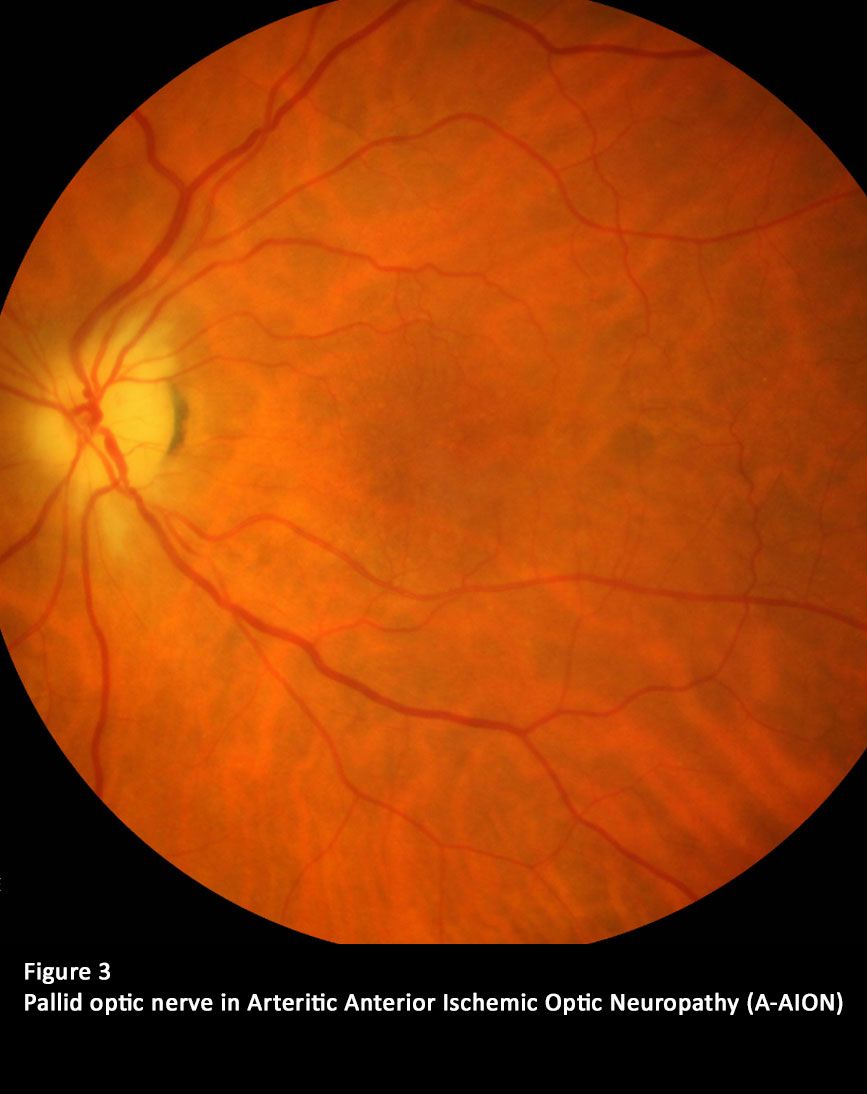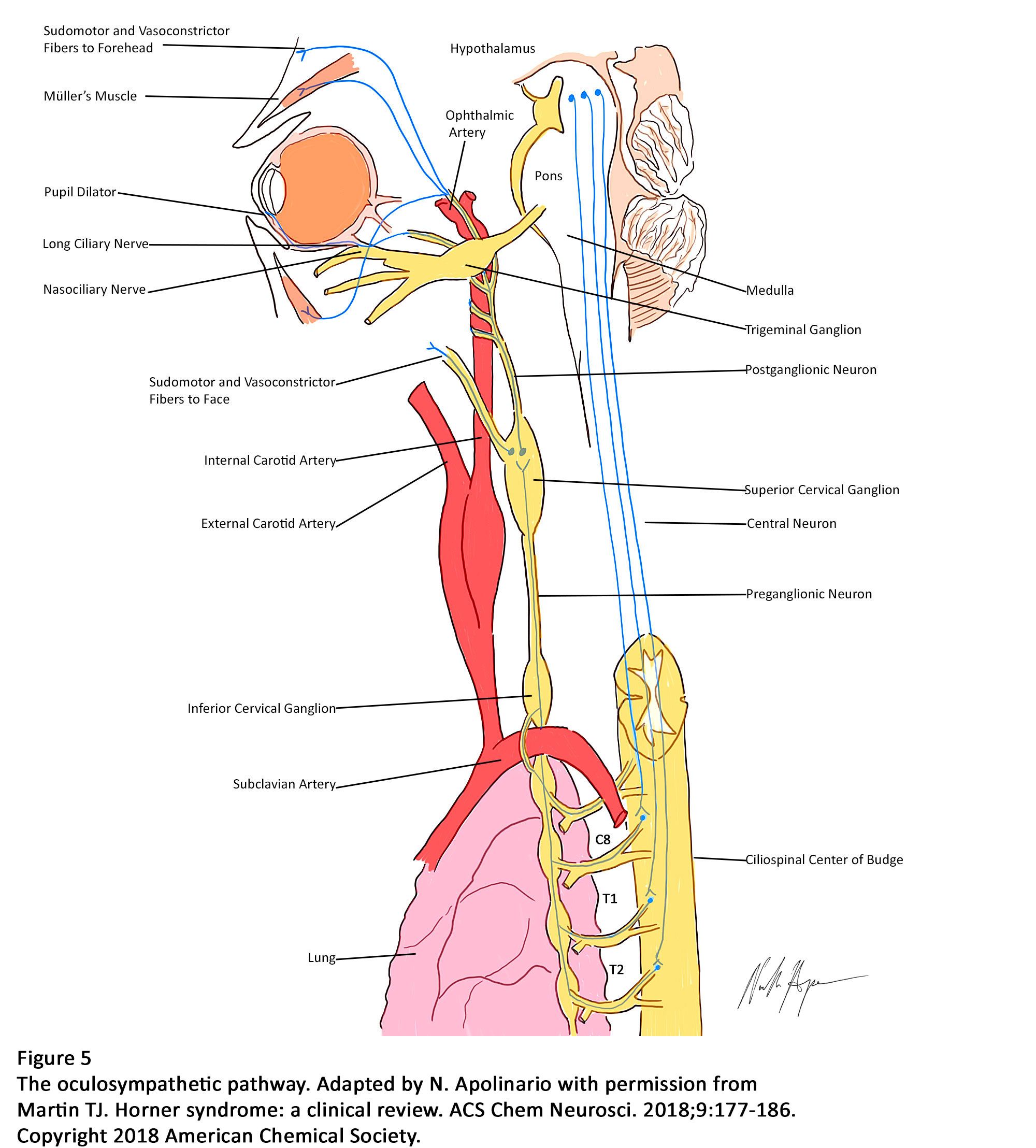Neuro-Ophthalmologic Disorders: Issues in Diagnosis and Treatment
Neurologists may be the first or only clinicians to recognize the 5 potentially dangerous neuro-ophthalmologic conditions described in this article.
©VladimirArndt/Shutterstock

Figure 1. Papilledema (OS) in a patient with IIH

Figure 2. Non-arteritic anterior ischemic optic neuropathy (NAION). ©American Academy of Ophthalmology, reprinted with permission. A. Fundus photo of the right eye of a patient with NAION showinging a swollen optic nerve with retinal nerve fiber layer hemorrhages in the peripapillary area and indistinct changes at the fovea. B. Macular line scan through the swollen optic nerve head and fovea of the patient shows the presence of intraretinal (arrow head) and subfoveal fluid (red arrow)

Figure 3. Pallid optic nerve in anterior ischemic optic neuropathy (A-AION)

Figure 4. Brain and orbit MRI showing enhancement of the right optic nerve in a patient with optic neuritis

Figure 5. The oculosympathetic pathway. Adapted with permission from Martin TJ[11] ©2018 American Chemical Society.

Mr Apolinario is a medical student, Texas A and M Health Science Center College of Medicine, College Station, TX. Dr Vickers and Dr Ponce are Neuro-ophthalmology Fellows at the Blanton Eye Institute, Houston Methodist Hospital, Houston, TX. Dr Lee is Chair, Department of Ophthalmology, Blanton Eye Institute, Houston Methodist Hospital, and Professor of Ophthalmology, Neurology, and Neurosurgery, Weill Cornell Medicine; Professor of Ophthalmology, UTMB and UT MD Anderson Cancer Center and Texas A and M College of Medicine (Adjunct); Adjunct Professor, Baylor College of Medicine and the Center for Space Medicine, the University of Iowa Hospitals and Clinics, and the University of Buffalo.
Neurologists may be first-line clinicians for patients who present with specific neuro-ophthalmologic conditions. Although these conditions may require co-management with an ophthalmologist or neuro-ophthalmologist, the neurologist should be able to triage and recognize the key and differentiating features of these common neuro-ophthalmic conditions:
(1) papilledema and idiopathic intracranial hypertension (IIH)
(2) anterior ischemic optic neuropathy(AION)
(3) optic neuritis
(4) ocular motor cranial neuropathy
(5) Horner syndrome. Early diagnosis and treatment of these conditions may be potentially life or vision saving.
Idiopathic intracranial hypertension
Idiopathic intracranial hypertension (IIH), also known as primary pseudotumor cerebri, refers to symptoms and signs of increased intracranial pressure (ICP) in the absence of a true tumor (space-occupying lesion) or other potential causes, such as venous sinus thrombosis,meningeal lesions, hydrocephalus/aqueductal stenosis, and others.1 Most commonly affecting younger, obese women, IIH is not completely benign and approximately 1% to 2% of patients suffer vision loss. The pathogenesis of IIH is unknown, although altered cerebrospinal fluid (CSF) production or absorption, abnormal vitamin A metabolism, endocrine dysfunction, and sleep apnea are proposed mechanisms.
Presentation and symptoms. Most patients with IIH initially present with a headache that may mimic migraine. The headache may be unilateral, bilateral, or diffuse; throbbing or non-throbbing in quality; and may be associated with nausea, vomiting, and photophobia. Differentiating features that separate IIH from migraine include pulsatile tinnitus, which is more specific for IIH, transient visual obscurations (lasting seconds at a time) rather than the typical fortification, scintillation scotoma of migraine, and diplopia due to sixth nerve palsies (a non-localizing sign of increased intracranial ICP). The key and differentiating sign of IIH is papilledema (Figure 1)-although it is not required to make the diagnosis. The most common visual field abnormality is enlargement of the blind spot, but any nerve fiber layer type optic nerve defect may occur (eg, arcuate, altitudinal, constriction, nasal step). Visual acuity is generally unaffected until late in the course of IIH but fulminant IIH may produce acute loss of central vision and should be treated more aggressively and urgently. Fulminant IIH may require surgical intervention.
Diagnosis and treatment considerations. IIH is a diagnosis of exclusion and therefore other causes of increased ICP should be excluded, including a mass lesion, venous sinus thrombosis, or malignant hypertension. The diagnosis of IIH is made based on the modified Dandy criteria (Table). Treatment of IIH is multidisciplinary and involves weight reduction, plus medical management including first line treatment with acetazolamide. Agents such as furosemide or topiramate have also been used with anecdotal success, but acetazolamide has been shown in a recent clinical trial to be an effective first-line treatment.2,3 Surgical interventions, such as optic nerve sheath fenestration, venous sinus stenting, or lumboperitoneal or ventriculoperitoneal shunting, may be necessary if maximum medical management fails or in the setting of fulminant IIH.
Anterior ischemic optic neuropathy
Anterior ischemic optic neuropathy (AION) is the most common cause of acute, unilateral optic neuropathy in adults.4 It is classified as arteritic (A-AION) or non-arteritic AION (NAION).
NAION is characterized by acute, typically unilateral, and painless loss of vision, an ipsilateral relative afferent pupillary defect (RAPD), and a swollen (sector or diffuse) optic nerve. A small cup to disc ratio (known as the structural “disc at risk”) is believed to be a predisposing risk factor for NAION (Figure 2). Other proposed risk factors include vasculopathic conditions (eg, hypertension, hyperlipidemia, diabetes, sleep apnea). To date there remains no proven effective treatment for NAION, but risk factors should managed to reduce occurrence in the fellow eye or a second episode in the same eye. Corticosteroids have been used with some anecdotal success. An ongoing clinical trial is underway to test anti-apoptosis agents given intravitreally.
In contrast to NAION, A-AION is caused by giant cell arteritis. A-AION can occur unilaterally or bilaterally and may be severe with rapid blindness in both eyes if not recognized and treated early. A pale and swollen optic nerve (ie, pallid disc edema) is highly suggestive of giant cell arteritis and A-AION (Figure 3). Fluorescein angiography might show choroidal perfusion delay in cases of giant cell arteritis (GCA) in A-AION but may be especially helpful in posterior ION where the disc is not swollen.
Patients with GCA often have other constitutional and systemic symptoms preceding the vision loss including jaw claudication, scalp tenderness, neck pain, and headache located in the temple. In addition, patient with GCA may experience transient visual loss (amaurosis fugax) episodes that are not seen in NA-AION. These red-flag symptoms should prompt additional testing for giant cell arteritis (eg, erythrocyte sedimentation rate, C-reactive protein, and platelet count). Prompt corticosteroid treatment should be considered to prevent further visual loss. A diagnostic temporal artery biopsy can be confirmatory of giant cell arteritis.5
Optic neuritis
One of the most common neuro-ophthalmologic disorders that present to neurologists is optic neuritis (ON).6 Idiopathic or demyelinating inflammation of the optic nerve (Figure 4) is referred to as ON. Patients with ON typically present with subacute unilateral vision loss, pain with eye movement, dyschromatopsia, relative afferent pupillary defect, and usually a normal or sometimes mildly swollen optic nerve.
In the Western hemisphere, ON is most commonly associated with multiple sclerosis (MS) and can be the presenting finding in up to 25% of cases. In addition to MS however, the differential diagnosis includes neuromyelitis optica (NMO) and neuromyelitis optica-spectrum disorders (NMOSD).6
NMO is an autoimmune disease characterized by an antibody-mediated attack against aquaporin-4 receptors and is characterized by longitudinally extensive (< 3 vertebrae) spinal cord lesions (transverse myelitis) in addition to ON. Patient with ON should be asked about symptoms such as unexplained nausea or vomiting, intractable hiccups, and excessive daytime somnolence, which would indicate involvement of aquaporin-4 rich areas.
Magnetic resonance imaging (MRI) of the brain may predict MS (periventricular white matter lesions); thus patients with ON should undergo neuroimaging (typically MRI of the brain and orbits with and without gadolinium). Additional imaging of the spine to evaluate for other lesions as well as evaluation for radiographic dissemination in time and space may be helpful. Patients with symptoms or signs of transverse myelitis should also be considered for spinal imaging.
Treatment. Findings from the Optic Neuritis Treatment Trial (ONTT) indicate that treatment of ON with intravenous corticosteroids may hasten visual recovery but does not change the final visual outcome.7 Treatment and evaluation of the underlying condition (eg, MS, neuromyelitis optica, sarcoidosis) should be considered, if present. In most cases, the visual loss in idiopathic- or multiple sclerosis-related ON is self-limited and spontaneously resolves in more than 90% of cases.8 Failure to recover is a red flag to consider an alternate diagnosis.
Ocular motor cranial neuropathy
Ocular motor cranial neuropathy often presents with diplopia and can present to a neurologist. In a patient with binocular diplopia, determining the direction of the diplopia (horizontal, vertical, oblique), location of the lesion, and its causes are important because treatment (eg, observation, medical treatment, surgery) depends on etiology. Three ocular motor cranial nerves control eye movements (the third, the fourth, and the sixth nerves) and damage can occur to a single nerve or combinations of the nerves. Multiple cranial nerve involvement should raise suspicion for a cavernous sinus process (including meningioma, carotid artery aneurysm, or inflammation), multiple lesion, or meningeal process. Myasthenia gravis should also be considered in any pupil spared, painless, non-proptotic, and ophthalmoplegic (including patterns resembling ocular motor cranial neuropathies).
The differential diagnosis. Isolated ocular motor cranial mononeuropathies are most commonly the result of microvascular ischemia from uncontrolled vasculopathic risk factors in older patients. A third-nerve palsy may be complete or incomplete, and either pupil-sparing or involving. The “rule of the pupil” suggests that a third-nerve palsy plus pupil involvement (relatively larger and less reactive) is due to a compressive lesion (such as an aneurysm) until proven otherwise. Therefore initial neuroimaging (CT, MRI) should include MR angiography (MRA) or CT angiography (CTA).
Partial palsy or partial pupil-involved cases also deserve neuroimaging, preferably with CT/CTA in urgent cases but followed by MRI/MRA if the CT/CTA is negative because MRI is superior to CT for non-aneurysmal causes of third nerve palsy. Standard catheter angiography may still be necessary in equivocal cases in which the CT/CTA or MR/MRA combination is inadequate to exclude aneurysm. If an aneurysm (typically posterior communicating artery) is present, referral to neurosurgery and/or endovascular neuroradiology is advised and the aneurysm may be clipped or coiled.
Isolated fourth-nerve palsy can be associated with trauma because it is the only cranial nerve that exits the brainstem dorsally, which renders it susceptible to axonal shear injury during trauma, especially in coup-contrecoup contusions. Fourth-nerve palsy may also result from decompensation of a congenital fourth-nerve palsy. This can sometimes be determined using prisms to measure fusional amplitudes. Congenital palsies have greater vertical fusion (up to 6 diopters) in general. Imaging and further evaluation should be considered in any unexplained, progressive, non-isolated, or atypical cases.
Sixth-nerve palsies can be caused by a non-localized sign of increased intracranial pressure. Downward shift of the brainstem is believed to stretch or compress the nerve as it travels in the subarachnoid space along the clivus. Sixth-nerve palsy with Horner syndrome can localize to the cavernous sinus (ie, Parkinson syndrome)-in which case, imaging should be considered. Neuroimaging should be considered for all cases of sixth nerve palsy but especially in patients without an alternative etiology, progression, or other atypical presentation for isolated ischemic mononeuropathy.
Giant cell arteritis may produce symptoms consistent with an isolated cranial-nerve palsy, so an erythrocyte sedimentation rate and C-reactive protein should be considered in patients aged older than 50 years.
Once other causes have been ruled out, a follow up at 4 to 6 weeks is recommended even for presumed vasculopathic, isolated, ocular motor cranial neuropathies. If there is no improvement, or if the history and examination suggest another cause (eg, myasthenia gravis), a more detailed workup and directed imaging should be considered. In general, isolated vasculopathic cranial neuropathies improve over the course of a few weeks to months. Patching the eye may provide symptomatic relief. Prism or strabismus surgery might be needed in unresolved cases.
Horner syndrome
Horner syndrome refers to a constellation of symptoms classically presenting as a triad of ptosis, miosis, and anhidrosis ipsilaterally. This condition results from damage to a segment of the 3-nerve chain that originates in the hypothalamus (first-order neuron), travels downwards through the brainstem to the spinal cord (second-order neuron), and returns upwards to synapse in the superior cervical ganglion (third-order neuron) before continuing on the internal carotid artery to the cavernous sinus and then to the iris and the Mueller muscle in the eyelid (Figure 5).10 While many causes of Horner syndrome are idiopathic and benign or iatrogenic (eg, open-heart or neck surgery), there are more other causes that may warrant further workup; these can include aneurysm, malignancy, posterior circulation infarct, and carotid or vertebral dissection.
Diagnostic considerations. Establishing the duration of symptoms is important for diagnosis, as well as collecting a thorough medical and surgical history. Reviewing a patient’s driver’s license or other old photographs may provide a baseline. Recognition of the classical triad often guides the diagnosis. Because other conditions may cause anisocoria or ptosis, testing with 0.5% apraclonidine in both eyes can differentiate Horner from other etiologies by causing the affected eye to dilate and the ptosis to reverse while causing minimal change in the unaffected eye. Cocaine drops may also be used if apraclonidine is unavailable or contraindicated.
Further testing with hydroxyamphetamine can localize the lesion; a preganglionic lesion will dilate normally in response to hydroxyamphetamine but a post-ganglionic lesion will not dilate as well as the normal pupil. Imaging of acute Horner requires an MRI of the sympathetic pathway from the hypothalamus to thoracic vertebrae 2 (T2), and in the acute setting headband neck CT and CTA to rule out carotid dissection.
The most concerning causes of Horner syndrome include malignancy, stroke, carotid dissection, and aneurysm. As the 3-neuron chain travels in close proximity to the apex of the lung and to structures in the neck, Pancoast tumors and thyroid tumors as well as metastases to these regions may produce Horner syndrome. In children, neuroblastoma is most commonly associated with Horner syndrome.
Stroke in the lateral medulla (Wallenburg syndrome) may also produce Horner syndrome but is usually accompanied by other medullary signs. In contrast, Horner syndrome associated with carotid dissection may be isolated or only accompanied by neck pain. As the dissection may generate thrombotic emboli, neuroimaging is indicated (eg, CT/CTA or MRI/MRA of the head and neck) and patients should be offered anticoagulation or antiplatelet therapy. Treatment should be directed towards the etiology of the Horner syndrome.
Conclusion
Neurologists may be the first or only clinicians to see potentially dangerous neuro-ophthalmologic conditions. They should be able to triage and recognize the key differentiating features of IIH, AION, ON, ocular motor cranial neuropathy, and Horner syndrome. Early diagnosis and treatment of these conditions may be potentially life or vision saving.
References:
1. Wakerley B, Tan M, Ting E. Idiopathic intracranial hypertension. Cephalalgia. 2014;35:248-261.
2. Corbett JJ. Problems in the diagnosis and treatment of pseudotumor cerebri. Can J Neurol Sci. 1983;10:221-229.
3. Kaufman DI, Friedman DI. Should acetazolamide be the first-line treatment for patients with idiopathic intracranial hypertension?J Neuro-ophthalmol. 2017;37:182-186.
4. Rucker JC, Biousse V, Newman NJ. Ischemic optic neuropathies. Curr Opin Neurol. 2004;17:27-35.
5. Hayreh SS, Biousse V. Treatment of acute visual loss in giant cell arteritis. J Neuro-Ophthalmol. 2012;32:278-287.
6. Toosy AT, Mason DF, Miller DH. Optic neuritis. Lancet Neurol. 2014;13:83-99.
7. The Optic Neuritis Study Group. Multiple sclerosis risk after optic neuritis: final Optic Neuritis Treatment Trial follow-up. Arch Neurol. 2008;65:727-732.
8. Lee AG. Neuro-ophthalmic afferent system diagnoses a general ophthalmologist should (almost) never make alone. Mid East African J Ophthalmol. 2009;16:41.
9. Cornblath WT. Diplopia due to ocular motor cranial neuropathies. Continuum (Minneap Minn). 2014;20:966-980.
10. Martin TJ. Horner syndrome: a clinical review. ACS Chem Neurosci. 2018;9:177-186.
11. Friedman DI, Jacobson DM. Diagnostic criteria for idiopathic intracranial hypertension. Neurology. 2002;59:1492.